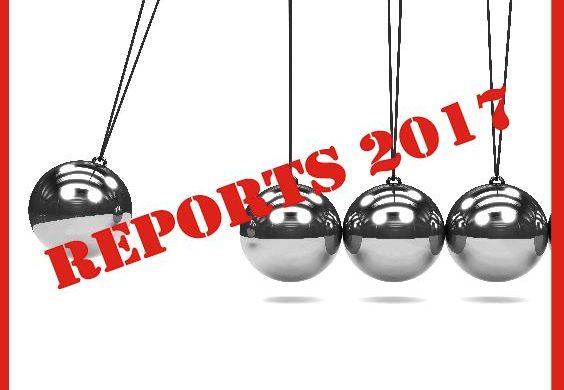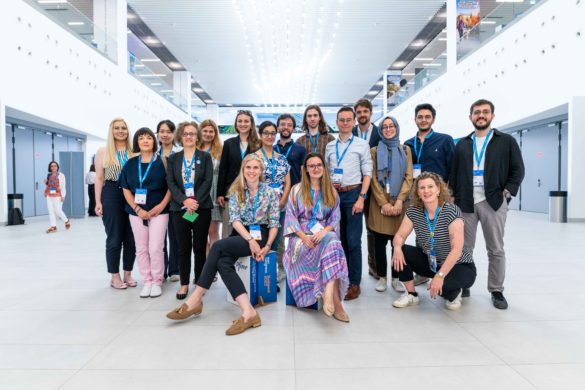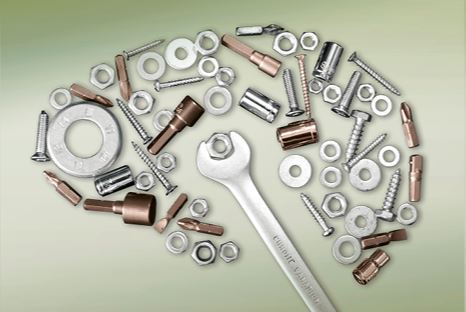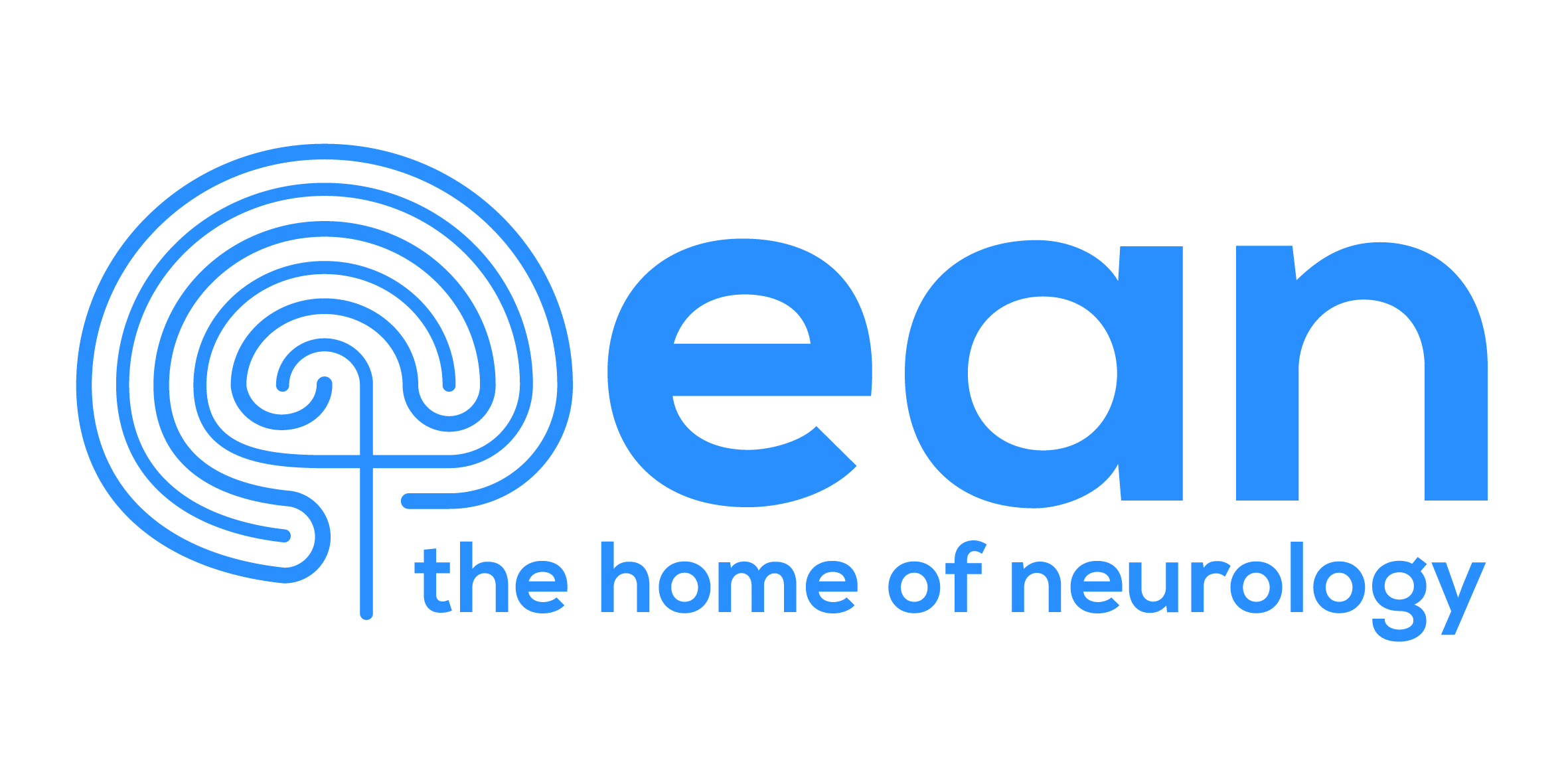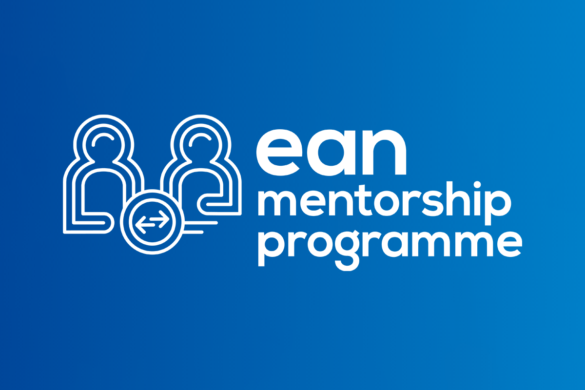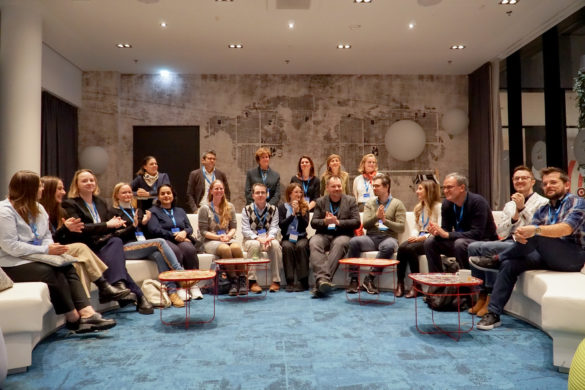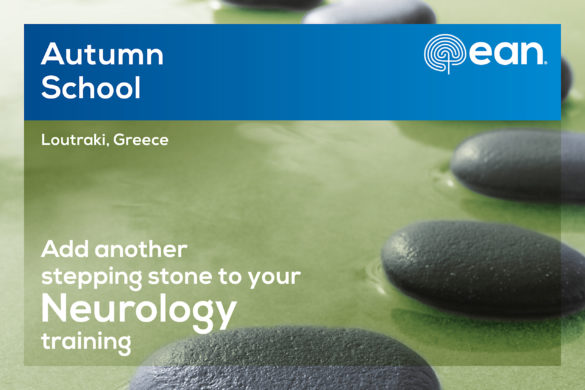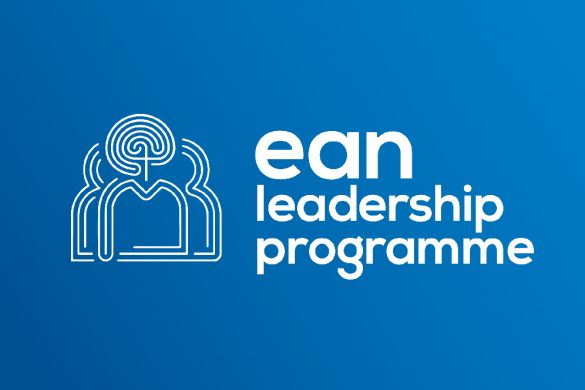Report from Sebastian Schreglmann from Switzerland visiting the Sobell Deparment, National Institute of Neurology and Neurosurgery (NINN), Queen Square, London under the supervision of Professor Kailash Bhatia
As a recipient of the EAN Department to Department Programme the following lines are intended to summarize my stay with the team of Prof. Kailash Bhatia from September 1st to October 30th, 2015.
From my previous work as a neurologist in training in Zurich and St. Gallen I have developed a particular interest in the field of movement disorders and knew Prof. Bhatias´ work from talks and publications. He is undoubtedly one of the most influential figures in current dystonia research and from staying 8 weeks as an observer I can confirm that his clinical experience is truly impressive.
After a quick introduction by his secretary to the organization of the clinical service at the NINN I was able to join Prof. Bhatia in all his movement disorder clinics and ward rounds during my observer period. A typical clinic would last from 9AM to 2:30 PM, in which a mixture of new and follow-up cases would be seen by either him or his research fellows (on a normal basis about 10-12 cases/clinic). The spectrum of cases would range from primary, isolated dystonia (e.g. writers cramp, cervical dystonia, blepharospasm), idiopathic Parkinson`s disease, atypical Parkinsonism, less frequent sporadic conditions (Wilson`s), combined movement disorder syndromes with varying leading clinical symptoms (pallido-pyramidal syndrome, NBIAs etc.), hereditary conditions (paroxysmal dyskinesia, recessive young-onset Parkinsonism, Huntington`s chorea episodic ataxia etc.) to rarer syndromic associations (fronto-temporal dementia & motor neuron disease – C9ORF mutation, benign hereditary chorea, mitochondrial syndromes with movement disorder phenotype). During his clinics Prof. Bhatia would regularly question the present fellows and visitors on various aspects of movement disorders ranging from prevalence, molecular/neuroanatomical or electrophysiological basis of disease, associated neuropsychological/psychiatric/histological features, diagnostic tests to be employed in this condition and medical or surgical management. Together with his very educative style this created the kind of stimulating environment I had expected to witness. Of particular note was his meticulous assessment of family history, guided through his extensive experience in the genetic basis of movement disorders. Through my work in the neurogenetics clinic in Zurich I already have had some exposure to this ever-increasing field of neurology, but this focus on proven and emerging genomic associations in the field of movement disorders was particularly thought provoking.
Along with the other visitors I also made use of the additional education resources at NINN, most prominent Gower`s grand rounds on Thursday afternoons, where interesting cases from the whole field of neurology would be presented to the summoned Queen Square crowd of neurologists, often creating very lively discussions.
As it is true that one most of the time only recognizes what one has already seen I am happy to say that my stay at Queen Square has broadened my clinical horizon in the field of movement disorders and I am positive that it will greatly influence my future work in movement disorders. I am very grateful to the EAN for giving me this opportunity and I would therefore like to conclude my report with a full-hearted “Thank you very much indeed!”.
*********************************
Report from Sanjar Mirdedaev from Uzbekistan visiting the Department of Neurology at the Antwerp University Hospital in Belgium, under the supervision of Professor Dr. Cras Patrick
I had a great opportunity to visit the Department of Neurology and Antwerp University Hospital (UZA) in Belgium for more than 6 weeks, with the help of the EAN Department to Department Co-operation Programme 2015, which influenced the approach to increase my professional career. It was an amazing lesson for my future to become an experienced neurologist.
I began my period on the 6th October,2015 in Antwerp University Hospital. Everything was arranged previous to my arrival: my accommodation, my contract with the hospital etc. From the very first moment I was given hospital equipment and was referred to the medical staff on the Stroke Unit and Neurology Department. There I found a friendly team that was willing to integrate and help me with everything needed, especially I would like to remark my supervisor Professor Dr.Cras Patrick.
In this programme I spent my time duration in the Neurology Department and Stroke Unit. The daily programme was from 8 am until 5-6 p.m. In the mornings we had observation of patients of the Department (IPD)and on Tuesdays and Fridays we did observation of ambulatory patients(OPD) with Professor Dr. Cras Patrick. Also I had discussion of patients with Radiologist and Neurosurgeon and Oncologist on Tuesdays and Fridays. One more thing in this meeting I had additional discussions with Professor Dr. Yperzeele Laetitia (stroke specialist) about the patients who are suffering from the stroke. As a result of this I can say that I had a big amount of information and increased my experience in Neurology treatment and Science. I found that to be very useful and educative. In my opinion, a close collaboration like the one in Antwerp between neurologists and radiologists is the success key to modern neurology.
Except this I was impressed in approaches for treating the Parkinson and Alzheimer diseases which one of the current issue in world neurology. This programme was the reason of improvement of my scientific work (“The principles of correction of complications of dopaminergic therapy of Parkinson’s disease”)
After that we spent a lot of time on the ward with the patients. I managed to learn more about their protocols and guidelines in treating strokes but not only that. I assisted my colleagues and as well performed lumbar punctures, withdrawal of blood, examining patients etc.
I took care of patients during scheduled intravenous treatment for myasthenia gravis, multiple sclerosis, and multifocal motor neuropathy. In outpatient clinics I was involved in management of movement disorders, epilepsy, and multiple sclerosis. Especially valuable were weekly clinic-radiological meetings where I had an opportunity to compare clinic with radiological investigations and on Tuesdays clinic discussions in Neurology department(from 13:00 to 14:00) and on Fridays we had presentations of success and limitation in modern neurology of the world.
Every time I remember with my heart with my colleagues Dr. Montagna and Van Loock under the supervision of Professor Cras we diagnosed, observed and made a treatment to one special patient from Holland during one and half month and as a result we saved her life. Her diagnosis was “Meningoencephalitis”. At first appeal she was in comatose condition, so far we did intervention as needed. As the result of treatment we saw her recovering and her family members and we were very happy for that. In my opinion as a doctor we did our best and got success.
As the end of my report I would like to emphasize my colleagues Dr. Massimilano Montogno and Katrine Van Look who did a lot of help and support for me during this sharing experience and I will never forget them.
This programme was very suitable to me and for arranging chance I am glad and express my thankfulness and deep respect to EAN organization and to the Professor Dr. Cras Patrick.
Overall, Antwerp University Hospital visit was an interesting, instructive and incentive experience which I would recommend to any of my colleagues in Uzbekistan and other countries.
**********************************
Report from Nadzeya Harbachova from Belarus visiting the Neuropsychiatric department for children of Carlo Poma Hospital, Mantova, Italy under the supervision of Professor Giuseppe Capovilla
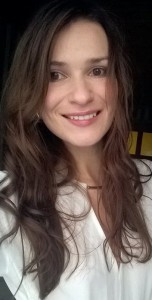 I came to Neuropsychiatric department for children of Carlo Poma Hospital, Mantova, Italy the 2nd of November, 2015 in the first time. I was kindly welcomed and introduced to the members of the Department, the short but thorough excursion on Department‘s structure was made for me. It was a pleasant moment and i felt myself very comfortable.
I came to Neuropsychiatric department for children of Carlo Poma Hospital, Mantova, Italy the 2nd of November, 2015 in the first time. I was kindly welcomed and introduced to the members of the Department, the short but thorough excursion on Department‘s structure was made for me. It was a pleasant moment and i felt myself very comfortable.
The Department receives outpatients and provide consultations for Pediatric Department, Neonatology, Intensive care and Emergency Units. Every day i could join the doctors‘ visits from 8.30 to 17.00, which was made in Italian and English languages and were very detailed with discussion after each visit. It was very helpfull for my clinical experience to have such an insight. I feel a gratitude now for the professionals teaching me.
I could use the Department’s database with access to video-EEGs and patients‘ histories, as well as library for studying. The discussion of the most difficult cases and journal club were performed every week with all the doctors and prof. Capovilla as a chairperson. I was glad to know about recent tendencies in modern epileptology. To know about the study of Z1 glasses and the method of EEG recording in photosensitive patients was spectacular. For instance, the concept of system epilepsies, the choice of an antiepileptic drug paying attention to particular EEG picture and structures of the brain involved, as well as the experience of not prescribing drugs in age-dependent epilepsies with ‘window of seizures’ and in cases of very rare seizures were novel for me.
I have enriched my humble experience of EEG performing and reading by accompanying technicians during their daily activities and doctors during making the reports. The Department has excellent technical supply and very high level experienced professionals.
I want to point out in particular the great achievements of the professor and doctors of the Department in differential diagnosis of nonepileptic and epileptic manifestations in children. I have familiarised myself with articles and video-EEG materials on that topic that were kindly presented to me.
During my stay I have visited two congresses: Epilepsy and Sport (Treviso, Italy) and the annual Neuropsychiatric Pediatric Congress (Bologna, Italy). My participation was possible with the help of the Lega Italiana contro l’Epilessia (LICE) president – Prof. Capovilla and Prof. Falsaperla. The congresses‘ materials will be shared with interested in belorussian doctors after my return to familiarise them with the experience of European colleagues.
The experience gained in this outstanding Department can not be undervalued and is of the great importance for my future carreer. So I am gratefull for being such lucky to visit exactly the Neuropsychiatric department for children of Carlo Poma Hospital in Mantova, Italy with professor Giuseppe Capovilla as a Chair.
********************************
Report from Bozena Klysz from Poland visiting the Charles University and General University Hospital in Prague under the supervision of Professor Evžen Růžička
My name is Bożena Kłysz and I am currently employed in 2nd Department of Neurology in Institute of Psychiatry and Neurology in Warsaw. I had pleasure to take part in Department – Department Co-operation Programme. My internship took place in Department of Neurology, Charles University and General University Hospital in Prague. I started my internship on the 14th September and finished on the 23rd October.
It was great time for me. During my stay there I learned a lot of useful things. I also saw a lot of interested patients and practices. I am mainly interested in movement disorders so I spent a lot of time in Movement Disorders Centre. I had great opportunity to learn more in this field of neurology. I learn more about neurological examination of the patients with movement disorders, how to examined them, and how to diagnose and treat them. I spent most of time in outpatient clinic, where I saw many patients with movement disorders such as Parkinson’s disease, atypical parkisonism, essential tremor, dystonia, Wilson’s disease, Hungtington disease and many other disorders. I had a chance to examined patients with rare disorders that I had not shown before.
On Wednesdays I participated in physiotherapeutic examination of patients with spasticity and then I observed how the patients were injected with botulinum toxin. I learned how to assess the spasticity and functional status of patients and how to planed the botulinum toxin dosages. On Fridays I watched how to inject botulinum toxin in patients with dystonia and some other disorders in which this kind of treatment can be used. I learned how to inject muscles in cervical dystonia and oromandibular dystonia.
I attended weekly meetings, which concerned problematic patients, which I found very interesting. It was very beneficial for me. I also took part in weekly seminars where doctors presented interesting neurological topics. Once a week I participated in meetings with doctors from Radiological Department where interesting MRI and CT scans were shown.
Two times I was in surgery unit, where the electrodes into the basal ganglia were implanted. I also learned how to programme deep brain stimulator and how to monitor it.
I also spent two days in Multiple Sclerosis Centre where I could learn more about multiple sclerosis, how to diagnose, treat and rehabilitate the patients with this disease.
I learned a lot about gait and posture disturbances in patients with movement disorders, multiple sclerosis and after stroke. I learned how to examine patients on GAITRite and stabilometric platform. It will be very useful for my daily practice in my department. I compile a new concepts and a new study with posturographic platform in Wilson’s disease patients.
Professor Evžen Růžička was a great host. All the doctors were very kind, helpful and they explained many interesting things to me. It is also very important that the doctors who work there, have large knowledge and a lot of experience, they are very friendly and always willing to share their knowledge.
I am very happy and grateful for the grant I received from EAN. The participation in Department – Department Co-operation Programme, gave me much experience. An internship in Department of Neurology, Charles University and General University Hospital in Prague was very beneficial for my further work in my home institution.
*********************************
Report from Mariya Petrova from Bulgaria visiting the Department of Neurology, Christian Doppler Klinik, Paracelsus Privatuniversitaet Salzburg, Austria under the supervision of Prof. Dr. Mag. Eugen Trinka
It is my great pleasure and opportunity to present to you the report on my seven-week stay at the Paracelsus Medical Private University, chaired by Prof. Dr. Mag. Eugen Trinka, in the frame of the EAN Department to Department Program.
My stay at the Department of Neurology was very well organized. Generally, during the day in the clinic I used to join the team at EEG/EP laboratory, where I took part in the analyses of more than 15 EEG/EP per day of patients with different conditions (such as epilepsy, infections of the nervous system, vascular diseases, tumors, dementias, MS and other autoimmune diseases, brain death, encephalopathy, etc.). As I was given full access to patients’ data, I was able to understand their history, specific problems, particular evaluations and solutions proposed by the team. I also spent some days in the monitoring unit, where I had the opportunity to see both intracranial and scalp long-term video EEG recordings of currently hospitalized patients.
During my stay I was also able to participate in the other daily activities of the department. Twice a week a noon-conference was held including presentation and discussion of various cases (incl. dizziness, restless leg syndrome, critically ill patients, NCSE, complications of thrombolysis, etc.). Further, at these conferences a completely new data in different neurological domains was presented, which gave me an additional opportunity to improve my practical skills and acquire new knowledge in different neurological fields.
Every Wednesday at 3:00 pm an Epilepsy-Conference was held which included presentation and discussion of complicated cases (including continuous Video Monitoring, MRI, fMRI, SPECT, and neuropsychology evaluation). Patient’s history was summarized, seizures and EEG were discussed and imaging reviewed. I was really impressed of the comprehensive method of analyzing complex seizure patterns, the various approaches of interpreting findings and the respective solutions offered. During the conference the multidisciplinary team (covering neurologists, neurosurgeons, neuroradiologists and neuropsychologists) took decision how to proceed: further tests such as intracranial electrode placement, WADA test or e.g. advice for resection of the epileptogenic focus.
In addition, on November 5, 2015 the Department of Neurology hosted the Spinal Cord Injury & Tissue Regeneration Center Sazburg Summit 2015. During the conference opinion leaders in the field gave series of interesting lectures, as well as results of numerous promising studies were presented.
Furthermore, the experience at the University gave me also an unique chance to enjoy the amazing city of Salzburg and to create new contacts and friendships with colleagues of different countries.
Finally, I would like to express my sincere gratitude to the EAN for giving me the chance to be part of this programme. In particular, I would like to thank my supervisor Prof. Dr. Mag. Eugen Trinka who gave me full support, both during grant application process and throughout the whole training. Additionally, I would like to cordially thank Dr. Markus Leitinger for being always there for me, patiently explaining everything and kindly supporting me during my stay. And last, but not least, I would like to to thank Priv. Doz. Dr. J. Dobesberger, Dr. G. Kuchukhidze and the entire staff at the department for their kindness and cooperation, as well as Prof. Dr. L. Traykov and my colleagues at my home department who helped me participate in this program.
***********************************
Report from Irina Popa from Romania visiting the Epilepsy Center in Erlangen, Germany under the supervision of Prof. Haio Hamer
For 6 weeks (from the 25th of October untill the 5th of December) I have visited the Epilepsy Center in Erlangen, directed by Prof. Haio Hamer. I have chosen this center because of the interest in Epilepsy Surgery for pharmacoresistent epilepsy. My activity there was well organised and structured even before I got there.
The schedule for one day looked like this: in the morning I started at 8 a.m. with the rounds in the Epilepsy Station where the doctors from the department discussed the patients with the nurses and EEG-technicians. After that, around 8.30 I attended the meeting with the entire Neurology Department and Neuroradiology where all the patient and their CTs/MRIs were reviewed. From 9 a.m. untill 2 p.m. I had free time to review the EEGs and other non-invasive presurgical investigations in order to make my own opinion about each case. At 2 p.m. I attended the EEG visits where the residents and the specialists working in the Epilepsy Center presented each case to Prof. Hamer and a comprehensive discussion followed each case presentation. For me, this was the most important meeting of the day because it was the time when I could ask the questions I had and I could also have an input in the evaluation of the case. My programme finished around 4.30-5 p.m.
Since Erlangen provides a lot of different tecniques in the pre-surgical assessment of pharmacoresistent epilepsy, I spent some days also in the Magnetencephalography (MEG) – here I was able to see MEG done in the context of source localization in epilepsy and also during research projects on healthy individuals. In Neuropsychology I have seen the protocol of neuropsychological assessment of patients and also WADA-testing for memory and verbal lateralization. I spent some days also in the Neuroradiology Department in order to get familiar with Voxel Based Morphometry (VBM) technique, an investigation used to scan for focal cortical dysplasias using the patients MRI – T1 MPRange sequence. Now, at my return, I am trying to implement VBM in the Center where I work in Romania. I have also spent a couple of days in Neuropathology Department, where Dr. Coras has shown me slides with examples of focal cortical dysplasias and tumors highly epileptogenic.
I can say that I was an active visitor, I have taken part in all the activities and I have given a feed-back each time I was asked. What I liked the most during my stay there, was the fact that I got in touch with non-invasive assessment methods which are not available in Romania. Secondly, I enjoyed the fact that all the activity in the center was well organized, there was a schedule with all the activities and the hours which made it easier for me to follow. Last, I have gained a lot of knowledge in EEG in ICU due to the fact that each Monday there was an EEG course organized on this theme.
As far as money is concerned, I have spent the entire grant. The accomodation costed 450 euros and this is because I was lucky. I have been hosted by a german family in a village near Erlangen. If I have lived in Erlangen probably I would have payed double for the accomodation. The rest amount of money I spent on transportation (which was quite alot because I lived far from the hospital and I had to take the bus back and forth from the hospital), food and different social activities organized by people from the hospital.
In the end, I can say that my stay in Erlangen was a fruitful one. I have gained new information and experience with presurgical assessment of intractale epilepsy and I have also been able to socialise and make connections with people in the same field as I.
*****************************
Report from Carlotta Stipa from Italy visiting the Great Ormond Street Hospital in London, United Kingdom under the supervision of Professor Helen Cross
I have always been interested in epilepsy and during the past year I’ve started studying clinical and genetic features of patients with encephalopathy and epilepsy referring to the Epilepsy Centre of IRCCS Institute of Neurological Sciences of Bologna.
During my three months at Great Ormond Street Hospital in London I attended the Paediatric Neurology division, under the supervision of Professor Helen Cross, Prince of Wales’s Chair of Childhood Epilepsy and Honorary Consultant in Paediatric Neurology at UCL Institute of Child Health, and Dr Christin Eltze, Consultant Paediatric Neurologist at Great Ormond Street Hospital and Honorary Senior Lecturer UCL-Institute of Child Health.
During my stay I attended the telemetry ward and I had the opportunity to observe the clinical management of patients admitted to the ward.
I could take part to the ward round, where clinical data and EEG recordings of patients with drug resistant epilepsy were discussed with clinicians and neurophysiologists.
I could sit with neurophysiologists and look at stereo-EEG recordings of patients admitted for seizure recording and pre-surgical evaluation.
I also went to weekly neuroradiology meetings, where neurologists, neurosurgeons, neuroradiologists and neurophysiologists present cases of surgical interest and discuss together about patients’ management.
It was also a great pleasure for me to be allowed into a lot of clinics. I attended general neurology, epilepsy, epilepsy surgery and ketogenic diet clinics.
I could also attend a really interesting clinic, the transition clinic, where paediatric neurologists, adult neurologists and specialist nurses manage together adolescent patients when they turn into adults. As a registrar in adult neurology, it was really important for me to see how they manage paediatric patients when they enter their adult life, as it is one of my interests and it will be one of the topics of my Master’s dissertation.
I focused my interest on patients with diagnosis of epilepsy and in particular on children with epileptic encephalopathy. I also increased my knowledge about phenotypic and genetic features of this disease.
In fact, I will continue working with Professor Cross and other GOSH clinicians as I am collaborating in writing a scientific paper with them.
I think I achieved my objective and I increased my knowledge of complex diagnostic practice in patients with encephalopathy and epilepsy, using neurophysiological, neuroradiological and genetic studies.
I had the opportunity to observe the correct clinical management of paediatric patients studying anamnestic, phenotypic, neurophysiologic and neuroradiologic features that can guide the clinicians from syndrome identification up to the correct choice for patient management.




